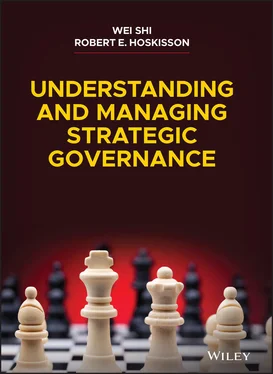Along with changes in the governance systems of specific countries, multinational companies' boards and managers also evolve (see Chapter 6). For example, firms that have entered more international markets are likely to have more top executives with greater international experience and to have a larger proportion of foreign owners and foreign directors on their boards. These encounters tend to shift governance systems toward more stakeholder-oriented systems in the United States and more shareholder-oriented systems in Europe and China and other emerging market countries.
Sources: Shi, W., Aguilera, R., & Wang. K. (2020). State ownership and securities fraud: A political governance perspective. Corporate Governance: An International Review 28 (2): 157–176; Aguilera, R. V., Valentina, M., & Ilir, H. (2019). International corporate governance: A review and opportunities for future research. Journal of International Business Studies 50 (4): 457–498; Oehmichen, J. (2018). East meets West—corporate governance in Asian emerging markets: A literature review and research agenda, International Business Review 27: 465–480; Foley, S. (2017). The battle of the US corporate governance codes, Financial Times, www.ft.com, February 5; Soltani, B., & Maupetit, C. (2015). Importance of core values of ethics, integrity and accountability in the European corporate governance codes, Journal of Management & Governance 19: 259–284; Aguilera, R. V., Judge, W. Q., & Terjesen, S. A. (2018). Corporate governance deviance, Academy of Management Review 43: 87–109; Chie, A., & Giovanni, G. (2017). Unstash the cash! Corporate governance reform in Japan, Journal of Banking & Financial Economics 37: 51–69; Lai, L., & Tam, H. (2017). Corporate governance, ownership structure and managing earnings to meet critical thresholds among Chinese listed firms, Review of Quantitative Finance & Accounting 48: 789–818; Du, X., Jian, W., & Lai, S. (2017). Do foreign directors mitigate earnings management? Evidence from China, International Journal of Accounting 52: 142–177; Lincoln, J. R., Guillot, D., & Sargent, M. (2017). Business groups, networks, and embeddedness: Innovation and implementation alliances in Japanese electronics, 1985–1998, Industrial & Corporate Change 26: 357–378; Schuler, D., Shi, W., Hoskisson, R. E., & Chen, T. (2016). ‘Windfalls of emperors' sojourns: Stock market reactions to Chinese firms hosting high ranking government officials. Strategic Management Journal 38 (8): 1668–1687; Berkman, H., Cole, R. A., & Fu, L. J. (2014). Improving corporate governance where the state is the controlling block holder: Evidence from China, European Journal of Finance 20: 752–777; Kosaku, N. (2014). Japan seeks to lure investors with improved corporate governance, Wall Street Journal , www.wsj.com, June 28; Li, J., & Qian, C. (2013). Principal-principal conflicts under weak institutions: A study of corporate takeovers in China, Strategic Management Journal 34: 498–508; Fiss, C., & Zajac, E.J. (2004). The diffusion of ideas over contested terrain: The (non)adoption of a shareholder value orientation among German firms, Administrative Science Quarterly 49: 501–534.
BOARD STRUCTURE AND PROCESS: EFFECTIVE BOARD STRATEGIC CONTROL AND MONITORING
Mainly driven by the argument under agency theory that top managers have too much power and thereby use the firm for better perquisites (such as compensation), board members abide by an institutional norm holding that governance should be focused on control and overcoming potential managerial malfeasance, which is often labeled as the audit culture . 21 Too focused on auditing, board members may not sufficiently emphasize the need for stewardship and providing strategic advice. As boards are primarily formed to oversee the decision-making processes of corporations, while CEOs and the top management teams are in charge of decision management, 22 strategic governance should center on better use of the human and social capital of board members to improve, and not just watch over, strategic decision-making. 23
Because of the audit culture found on many boards, outside directors have not been used fully to contribute to strategic decision-making. However, outside board members can help shape the content, context, and conduct of strategy formulation. 24 According to a survey by Russell Reynolds Associates, 25 boards of companies that exceeded total shareholder return (TSR) compared to relevant benchmarks for two or more years in a row spend more time on forward-looking, value-creating activities such as strategic planning and review and oversight on major strategic transactions, and less time on audit or compliance activities than their fellow directors on other boards. As a result, “the emphasis on board independence and control may hinder the board contribution to the strategic decision-making.” 26
To facilitate better strategic governance, we examine the relationship between the board chair and the chief executive officer. As mentioned, the audit culture prompted by agency theory 27 creates a relationship between a CEO and a control-oriented chair marked by distance and authority. This relationship does not always need to be solely control-oriented and can have a collaborative approach in which the board chair provides strategic advice. For example, when Hewlett-Packard split into two companies, Meg Whitman became CEO of Hewlett-Packard, Inc., and at the same time board chair of Hewlett-Packard Enterprise. She said in a CNBC interview: “I know the role of the chairman, and I know how it is different than the role of the CEO. The chairman is not there to run the company. The chairman [role] is to help the board be productive, help the CEO be successful.” As Whitman suggests, the chairman may play a supportive role to the CEO, providing a close source of advice and guidance. 28 Also, separating the CEO and chair roles (as opposed to cases in which the CEO is also the chair), as Whitman did, may enhance CEO–board collaboration by reducing the demands on the chief executive's time, allowing the CEO to specialize in managing the firm's strategy and operations.
Although many firms still assign the chairman position to the CEO to provide a unitary authority structure, 29 some scholars under the agency theory advocate for separate roles to provide better control of management. 30 Having the positions as separate roles with a collaborative board chair can provide both improved strategy and better board leadership. Research supports this conclusion, finding that board chairs can provide significant value (up to 9 percent improved firm performance) through advice and counsel, legitimacy, information linkages, and preferential access to external commitments and support. 31 This approach proves particularly beneficial when firms face fast-changing external environments such as in high technology firms. In essence, by providing improved strategic governance, board chairs can add significantly to firm value.
Board members who chair key board committees can also add to firm value through their approach to strategic governance. 32 In fact, the importance of board committees has grown over time due to increased legal requirements and the growing complexity of the business environment. 33 Research tells us about the overall board structure or board member demographics, such as functional backgrounds and ages, but not so much about the detailed work of directors that mostly occurs in committees. In particular, all boards, especially in Western cultures, have committees that identify new board members and facilitate CEO search processes (nominating and governance committees), set executive compensation (compensation committee), and oversee financial reporting (audit committee). These three dominant committees are today required by public stock exchanges and the SOX Act. The SOX Act additionally requires that they be headed by independent outside directors—those that are not inside managers and have no stakeholder affiliation (such as legal representation or customer or supplier relationship). The three committees, part of the audit culture, function to protect shareholders and other stakeholders from managerial malfeasance. Managers should not have the power to nominate board members that supervise their decisions, set their own compensation, or make aggressive or fraudulent accounting decisions.
Читать дальше












